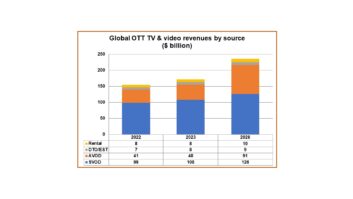
Subscription video on demand (SVoD) services such as Netflix were available to 1.3 per cent of emerging market households in 2014, with a user base of 19.4 million. This number is expected to grow to 6.4 per cent by the end of 2019, increasing the user base to 102.7 million. This shows the extent to which OTT video has grown not only in developed regions but also in emerging markets, both as an alternative and as a complement to established free-to-air (FTA) and pay-TV platforms. The news comes in the same week as Wuaki TV, owned by Japanese e-commerce company Rakuten, announced its plans to expand to ten more countries, and Netflix’ hope to have a presence in 200 countries over the next two years.
Daniele Tricarico, senior analyst at Pyramid Research, which led the report, commented: “In recent years, OTT business models entirely relying on advertising revenue streams have become difficult to sustain, given the high cost of content. In many emerging markets, we are witnessing the emergence of hybrid models, whereby services offer free content to expand the user base, but at the same time position premium SVoD and transactional video on demand (TVoD) services to generate additional revenue.”
In Africa and the Middle East, as more paid services emerge and advertising-funded video on demand (AVoD) services increasingly position SVoD for premium content, Pyramid Research expects the total paid OTT revenue (SVoD and TVoD) to expand in the next five years to represent 7 per cent of the regional pay-TV revenue. Accessing VoD services has until relatively recently not been possible in much of Africa, due to a lack of affordable, reliable bandwidth needed to operate. There is also the issue of a still-flourishing market for pirated DVDs, which are far more affordable than retail-cost content. However, the VoD market is expected to grow rapidly due to most users connecting to the internet and accessing services through mobile devices rather than fixed devices. The market has been largely dominated by start-ups, though earlier this month, VoD service FrontRow was launched by major telecom provider MTN Africa.
In Central and Eastern Europe, the impact of SVoD has been so far very limited, with TVoD more common. However, “SVoD adoption will pick up in the forecast period as the leading providers seek to monetise from the pervasiveness of online video through both TVoD and SVoD,” Tricarico said. According to the report, paid OTT revenue will grow to represent 5 per cent of pay-TV in the region in 2019. However, the issue of piracy again poses a problem in these territories: for example, in the Czech Republic, ultotzu.cz has been used as alternative to the likes of Netflix, allowing users to download pirated material at higher download rates, for a lower cost.
Emerging Asia Pacific and Latin America accounted for 90 per cent of paid OTT revenue in emerging markets in 2014, with Latin America being the only emerging market region where Netflix operates. The two regions will only drop marginal shares in the next five years, still making up 86 per cent of the total in 2019. “In China the proliferation of hybrid models combining AVoD and SVoD will be a major driver for growth,” added Tricarico. “4G, fibre broadband and e-commerce will support growth of OTT, but content regulation may hamper evolution in the near term. As the paid OTT opportunity strengthens in China, the regional Asia Pacific market will pick up from 2015-2016 onward.”







